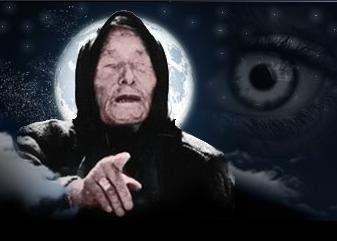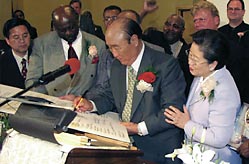Rev. Moon's Church Foundation 100 Years After His Birth
The Unification Community 100 Years After the Founder’s Birth: Are We There Yet?
One hundred years after the birth of Jesus, the small group of Christians had grown to approximately 7,500 followers - 0.0126% of the population of the Roman Empire. Thus, the Unification movement should have 291,000 members... a comparable level as the Christian movement in 100 AD. In the first 100 years, Christianity existed in a limited area around the Mediterranean. Unification communities currently exist in more than 150 countries.
Where are we and where do we want to be?
By month’s end, the global Unification Family will celebrate 100 years since the birth of Rev. Sun Myung Moon and 60 years since his marriage to co-founder, Hak Ja Han, in 1960.
It might be helpful for us to take an honest look at where the Unification Community is at currently in relation to where it wants to be.
In this article, I draw comparisons between the early Christian movement and where it stood after the birth of Jesus in the year 100 A.D. and the Unification Community in 2020. Estimates of the growth of early Christianity are referred to.
Of course, there are different approaches one can take to assessing the current situation. One can be totally optimistic and conclude that the movement founded by True Parents is far beyond God’s expectations. One can be consumed by idealism. On the other hand, some may consider a more pessimistic view and conclude that the Unification Movement is not growing as rapidly as it could. Some may even say that it is in decline.
Is the glass half full or half empty?
More that 40 years ago, Rev. Moon asked a gathering of members, “Why are we here? What is our purpose?” Various answers were entertained until one young 20-year-old in the front row responded: “To restore the world,” to which the founder responded, “That’s right. We are here to restore the world.” A tall order by any measure.
We may refer to the ultimate goal and founding ideals by the Unification term “building Cheon-il Guk,” which is a Korean abbreviation of Cheonju Pyeonghwa Tongil Guk, and translates as “Cosmic Nation of Unity and Peace.” Other similar terms are “Kingdom of Heaven,” “The Ideal World” or “One Family Under God.”
Given current global realities, that include the threat of wars, actual conflict in many jurisdictions, terrorist actions, environmental disasters, family breakdown, and moral decline, it is clear the world is a far cry from realizing an ideal on earth. Or is it?
On the contrary, some would suggest the world has never been closer to realizing the age-old dream of a unified and peaceful world. The ease of travel, communication and the global advances in technology may provide for a more hopeful perspective.
The early Christian movement founded by Jesus of Nazareth started with much hope and some scholars suggest that during his short three-year ministry, Jesus had gathered a substantial following in the thousands and had some sympathetic supporters in high places.
Consider that Nicodemus was a Pharisee and a member of the Jewish ruling council, the Sanhedrin. He is mentioned as being in dialogue with Jesus in John 3:1-3 when he asks:
“Rabbi, we know that you are a teacher come from God; for no one can do these signs that you do, unless God is with him.” And Jesus answered him, “Truly, truly, I say to you, unless one is born anew, he cannot see the kingdom of God.”
Gamaliel was a Pharisee and doctor of Jewish law. He was a man held in great esteem by all Jews according to Acts 5. He is famously quoted in Acts 5:38:
“So, in the present case I tell you, keep away from these men and let them alone; for if this plan or this undertaking is of men, it will fail; but if it is of God, you will not be able to overthrow them. You might even be found opposing God!”
Joseph of Arimathea, the man who assumed responsibility for the burial of Jesus after the crucifixion was a high counselor and a voting member of the Sanhedrin. His loyalty to Jesus was kept secret.
All three men, Nicodemus, Gamaliel and Joseph of Arimathea, were members of the Sanhedrin, a Jewish judicial body at the time that was tasked with the trial of Jesus according to the gospels. It was the Sanhedrin that took Jesus to Pontius Pilate and asked that he be tried for claiming to be the King of the Jews. Understandably, there are varying views about the role of the Sanhedrin and what led to Jesus’ execution at the hands of the Romans.
With the crucifixion of Jesus, the disciples scattered and Christian growth did not happen until later.
The first century of Christianity was also one of disputes and various factions within the Christian family. There were tensions between the Apostle Peter and James “the Lord’s brother” as well as with a later convert, Paul of Tarsus. One such dispute was settled at the Council of Jerusalem as recorded in Acts 15 and it was concluded that Gentile Christians would not be bound by Jewish ceremonial rules. The first century saw the beginning of other theological and organizational disputes among various factions that eventually led to the many factions and denominations of the Christian movement today.
One hundred years after the birth of Jesus, scholarly estimates are that the small group of Christians had grown to approximately 7,500 followers in the Roman Empire. The population of the Roman Empire in 100 A.D. was approximately 60 million and the estimated population of the entire world at the time was no more than 200 million.
For context, the global population 2,000 years ago was no more than the current national populations of Brazil, Nigeria or the United States. The population of the vast Roman Empire, which included an area that encompassed much of Europe, the Middle East and North Africa, was between 50 and 60 million, comparable to the current population of South Korea, South Africa or Colombia.
With these basic facts as a backdrop, consider the findings of Rodney Stark in his 1996 book, The Rise of Christianity: How the Obscure, Marginal Jesus Movement Became the Dominant Religious Force in the Western World in a Few Centuries, who claims Christianity grew to comprise over 50% of the population of the Roman Empire by 350 A.D. by simply growing at a rate of 4% per year or 40% per decade. According to him, by 100 A.D. there were approximately 7,500 adherents of the Christian movement which was only 0.0126% of the then population of the Roman Empire of approximately 60 million.
Stark, a sociologist of religion, contrasted his findings about the growth of the early Christian church with the growth of the Church of Jesus Christ of Latter-day Saints (LDS) since its inception in the first half of the 19th century. Writing in the late 1990s, Stark suggested that LDS could, within a century, grow to membership levels of 250 million simply by sustaining growth rates of 4% per year.
How then, does the Unification faith community compare 100 years after the birth of Sun Myung Moon? Where are we in relation to where we want to be? Certainly, the ultimate goal of world peace is a visionary one and will take time. A more pertinent comparison may be to the levels of growth achieved by Christianity during the first decades and centuries after the birth of Jesus.
The global population is currently estimated at 7.7 billion. As mentioned, the global population in 100 A.D. was approximately 200 million. The 60 million population of the Roman Empire at the time was about 30% of the world’s population.
Thirty percent of the current global population would be 2.31 billion and is a reasonable comparison. If we use Stark’s estimate of Christianity comprising 0.0126% of the population of the Roman Empire as a benchmark, a comparable number of “members or supporters” as a percentage of 30% of the global population would be about 291,000 people. Thus, the basic conclusion is if the Unification movement currently has 291,000 adherents or members, it is currently at a comparable level as the Christian movement in 100 AD.
Certainly, some may assume that the Unification community is far beyond that number when considering the ongoing blessings. Some may have to do more research!
The Marriage Blessing of the Unification movement is world famous. Many may not know much about the teaching or theology of the Unification faith community, however, the mass weddings are well known in many circles. Consider that since 1960 hundreds of thousands of couples have been blessed in marriage in Unification ceremonies. Beginning with three couples in 1960, 33 couples in 1961, 72 couples in 1962, 124 couples in 1963, 430 couples in 1968, 777 couples in 1970, 1800 couples in 1975, 2075 and 6000 couples in two separate ceremonies in 1982, in addition to many smaller and larger marriage blessing ceremonies until now.
There have also been very large marriage blessing ceremonies of 30,000 couples in 1992, 360,000 couples in 1995 and later blessings of millions of couples since. In the past few months, tens of thousands of couples participated in marriage blessing events in Cambodia, Taiwan, Niger, South Africa, and more. Some may question the level of involvement or the numbers circulated, certainly issues that should be addressed.
Keep in mind that Sun Myung Moon did not start active outreach until August 1945 with the end of Japan’s occupation of Korea and World War II. Some of the first members to join in 1946 in North Korea remained faithful to the cause for the rest of their lives. Later, due to Rev. Moon’s imprisonment in North Korea from 1948 to 1950 and the devastation caused by the Korean War (1950-53), the Unification Community was not officially registered as HSA-UWC until May 1954. Thus, the growth curve is between 66 and 75 years as of 2020.
The following chart provides a comparison of the estimated growth of Christianity during its first 350 years with Unificationism at a 4% annual growth rate. Bear in mind the numbers are simply hypothetical projections for the Unification context and do not represent the actual level of growth for any given year. For example, there were not 17,000 Unification members in 1960 and most likely there weren’t 28,000 members in 1970. The chart simply provides projections based on Stark’s model of how Christianity grew to 50% of the population of the then Roman Empire at a rate of 4% per year and what it should look like in the year 2020 for the Unification Family.
Of course, we do not have a clear definition of what the qualifications for membership were during the Christian era. Was a member someone who attended church services once a week? Or someone that partook of communion monthly or once a year? Or one who attended services only on Easter Sunday and Christmas Eve?
And if the early Christians kept records of regular donors, how often did they donate? And how many hours did they volunteer to promote the faith per week or each month?
Similarly, one could observe the growth of the Unification faith during the 20th and early 21st century and ask similar questions. What is a member? What is a supporter? Are there secret supporters similar to Joseph of Arimathea? Interested sympathizers such as Gamaliel and Nicodemus? What membership criteria is relevant?
Compared to the early Christian period there are similarities but also differences.
During its first 100 years, Christianity existed in a limited area around the Mediterranean. Unification communities currently exist in more than 150 countries. There are conflicts, disputes and factions today as there were then — some obvious and others more discreet.
In terms of numbers and global influence, there are observers who may take the view that Unificationism is a passing phenomenon. Still others have suggested the Unification Community could be a mere footnote in history.
Yet there are many videos, speech transcripts, memos, and reports of events on social media and the Web by which one could easily dispute such a view. It would be a massive footnote indeed!
Developments in past decades show there has been interest by people in high places with leaders of countries and various religious groups and NGOs supporting the global vision of the founders. There is also evidence of support for the Unification marriage blessing movement by significant numbers, especially in Asia and Africa. The hundreds of thousands and millions of couples who have participated in the marriage blessing and their children are connected in some way. But are they members? It really depends on how one looks at the results and assesses the current situation.
Some may brush off such developments and take a cynical or even an antagonistic view based on theological or other grounds. There are devoted followers who will see signs of progress that confirm their idealism. Some simply observe and are not ready to commit one way or the other.
Still others may take Gamaliel’s position: that if it is of God, nobody will be able to stop its growth and one may be found opposing God if they do.
There are simple, faithful and idealistic views and also complex, statistical views to consider.
At 100, the Unification Family may not be where it wants to be ultimately. The ideal has definitely not been established on earth yet and there is much more to be done.
At the same time, definite progress has been made and the glass is far from being half empty.
The Unification Family may indeed be much further along than the early adherents ever dreamed.♦
Rev. Franco Famularo (UTS Class of 1994) lives in Montreal and serves as National Leader of FFWPU Canada. He is also Chair of the Board of Trustees of Unification Theological Seminary.
 AFRICA PEACE SUMMIT 2018: DR. HAK JA HAN MOON
AFRICA PEACE SUMMIT 2018: DR. HAK JA HAN MOON 2020 THE BEGINNING OF A NEW AGE
2020 THE BEGINNING OF A NEW AGE LIFE OF REV. MOON, WASHINGTON TIMES FOUNDER
LIFE OF REV. MOON, WASHINGTON TIMES FOUNDER PRESIDENT OF PERU ABOUT SUN MYUNG MOON'S WORK
PRESIDENT OF PERU ABOUT SUN MYUNG MOON'S WORK REV. MOON BY PROFESSOR OF RELIGIOUS STUDIES
REV. MOON BY PROFESSOR OF RELIGIOUS STUDIES MOON'S MASS MARRIAGES: THE GIFT OF LOVEFEDERATION
MOON'S MASS MARRIAGES: THE GIFT OF LOVEFEDERATION REV. MOON'S KEY ROLE IN THE COLLAPSE OF COMMUNISM
REV. MOON'S KEY ROLE IN THE COLLAPSE OF COMMUNISM WHAT AWARDS SUN MYUNG MOON RECEIVED?
WHAT AWARDS SUN MYUNG MOON RECEIVED?



























